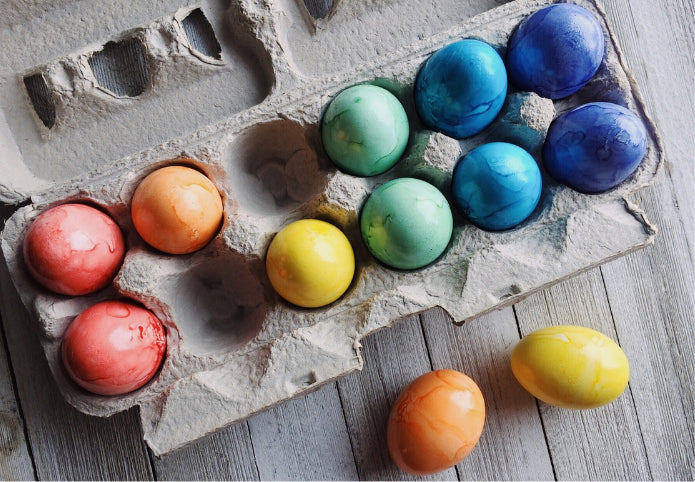Dyeing Easter eggs is a popular family tradition that we certainly look forward to, but artificial dyes may cause adverse reactions, hyperactivity, or agitation in some people (particularly children). As a result, we avoid them when at all possible.
Fortunately, making natural dye with ingredients from your kitchen is simple and fun! Learn how to make natural dyes using common kitchen ingredients in this guide.
The Benefits of Natural Dye Alternatives
Natural dyes are a fantastic alternative if you’re looking to avoid traditional food dyes or save money by using ingredients you likely have around your home.
Recent research shows that food dye affects humans, especially children, in undesirable ways. While food dyes don’t cause health conditions like anxiety or ADHD, they can exasperate the symptoms or cause children without them to become agitated. Unfortunately, the average person in the United States consumes five times as much food dye as people did in 1955. While research is still ongoing about the effects of food dye consumption, Ohio State University recommends checking food products for them and avoiding artificial dyes when possible. Other countries, like the United Kingdom, have already banned some of the food dyes we still use in the United States, demonstrating the seriousness of these products.
Researchers believe that food dye may promote histamine production, which causes you to feel alert. While not bad in small amounts, too many histamines can cause hyperactivity and agitation. Researchers note that young children and teens are the most likely to react to food dyes, but adults may still feel the effects.
Either way, natural dye alternatives are plentiful and easy to use, to save money and avoid potential adverse effects from artificial dyes.
Reds, Yellows, and Oranges
For vibrant, warm-toned dye alternatives, consider the following herbs and spices to decorate your eggs without using synthetic dyes.
- Red: Chili powder (reddish brown), red onion skins
- Orange: Curry powder, paprika powder
- Yellow: Safflower petals, turmeric powder
- Maroon: Chopped beets (use on brown eggs), red wine
- Gold: Yellow onion skins
- Pink: Chopped beets (use on white eggs)
Blues, Greens, and Purple
For cool-toned shades, try these natural dye options:
- Reddish blue/purple: Hibiscus flowers
- Indigo blue: Red cabbage (long soak) — this option sounds strange, but boiling red cabbage releases a beautiful purple liquid that gives eggs a purplish blue color.
- Green: Turmeric and cabbage (soak in turmeric first, then in cabbage)
- Light blue: Red cabbage (light soak)
- Purple: Red wine (long soak)
- Lavender: Blueberries
Neutral and Soft Shades
If you’re looking to dye your eggs a softer neutral color, consider these natural dye options:
- Deep brown: Coffee (use on brown eggs)
- Off-white: Black tea
- Reddish brown: Chili powder
- Soft brown: Dill seed
- Tannish yellow: Yarrow
- Pale yellow: Turmeric (light soak)
- Light pink: Light soak in room-temperature beet solution
How To Dye Easter Eggs Naturally
After you’ve chosen your dye colors and boiled your eggs, take the following steps to dye Easter eggs naturally.
- Allow your hard-boiled eggs to cool completely before dyeing them.
- Put each dye ingredient into its own pot with around one quart of water and two tablespoons of distilled white vinegar. Vinegar helps the color adhere to the eggs.
- Bring the water to a boil and let the pot bubble for at least 30 minutes. The longer the dye mixture cooks, the stronger the colors will be.
- Remove the mixture from the heat and let the liquid cool completely.
- Strain out the solids (for example, remove the beets, tea infuser, or onion skins)
- Pour the dye mixture into wide-mouth bowls for dyeing—be cautious, as the dye may stain whatever it touches.
- Add your hard-boiled eggs to the bowls and let them sit until they achieve your desired color. At a minimum, let the eggs sit for 30 minutes for a “light soak” that’ll produce a softer, pastel color. Let the eggs soak for a couple of hours if you're looking for intense colors.
- Carefully remove the eggs with a spoon and lay them on paper towels or rags to dry.
Must-Know Tips
To ensure your project is a success, we recommend following these quick tips:
- If you’re looking for richer colors, consider purchasing brown eggs, as this darker base color will make it easier to achieve a darker color. White eggs take longer to achieve deeper colors, but either way, you can create a beautiful color with these dye options.
- Hibiscus tea creates a unique blueish-gray tone! We recommend brewing a strong batch of tea. For example, use enough tea for eight cups of water, but only use four cups of water to amp up the color.
- Consider the strength of the ingredients you’re using. Turmeric and beets have naturally strong pigments, so you’ll only need one bunch of beets (1-2 tablespoons powder) or a tablespoon or two of turmeric to create a dye. However, softer colored ingredients like onion skins or dill seeds require a larger quantity of ingredients to create an intense color.
- Dye can last in the fridge for several weeks when properly sealed in a Mason jar or an airtight container, so you can continue dyeing eggs well past Easter!
Have fun experimenting in the kitchen with other food options! We’ve seen some try other options like Swiss chard or spinach with mixed results, but others have had great success using frozen fruit, such as cherries. The fun is in the process, so have fun, get messy, and have a blast dying your eggs the all-natural way.
Happy Easter!
Herbalist Natalie
 |
Natalie Hajdu-Voakes is a consulting herbalist and the owner of The Herb Stop, with over 28 years of hands-on experience in crafting herbal remedies and promoting natural wellness. |

